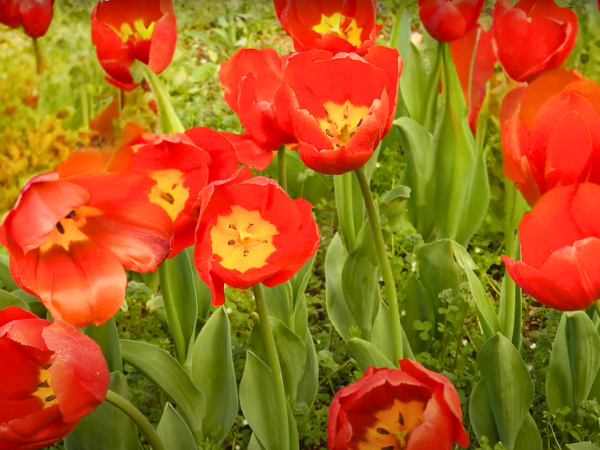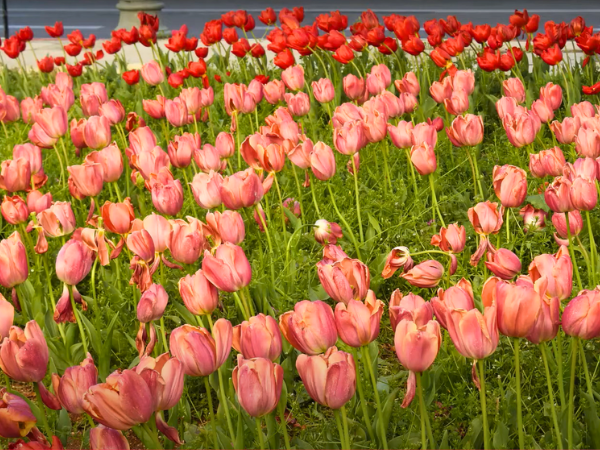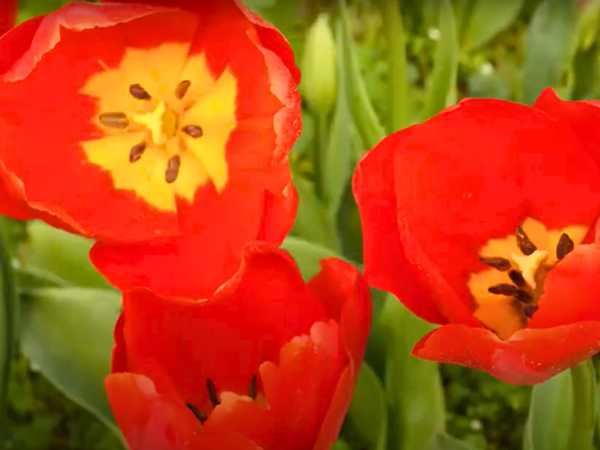The Jerusalem Tulip, known for its striking colors and delicate petals, has a story that spans centuries. Originating from the Middle East, this flower symbolizes beauty and resilience.
Caring for the Jerusalem Tulip requires some knowledge, from soil type to watering needs. Understanding these aspects helps gardeners nurture this stunning plant.
What Is The Jerusalem Tulip?
The Jerusalem Tulip is a rare, red-petaled wildflower. It is native to the Middle East, particularly found in Israel and Palestine. This flower has a striking appearance with its vibrant colors. Many admire it for its beauty and cultural ties.
Key characteristics of the Jerusalem Tulip include:
- Deep red petals.
- Black centers that create a stunning contrast.
- A low-growing habit, typically reaching 10-30 cm in height.
The Jerusalem Tulip blooms in early spring. It often blooms alongside other wildflowers, creating a colorful landscape.
Botanical Classification And Appearance
The Jerusalem Tulip belongs to the Tulipa genus. This genus includes many species of tulips, known for their beauty. The specific species of the Jerusalem Tulip is Tulipa agenensis. It is a perennial plant, meaning it comes back year after year.
In terms of appearance:
- Its petals are smooth and waxy.
- They have a trumpet-like shape.
- The black center adds to its striking look.
These tulips thrive in well-drained soil and sunny locations. They can often be found in rocky or dry areas, showcasing their adaptability.

The History And Cultural Significance
This unique plant tells a story of resilience and beauty in the landscapes of Israel. Understanding its background helps us appreciate its value in nature and local traditions.
Origins And Natural Habitat
The Jerusalem Tulip, known scientifically as Tulipa agenensis, has its roots in the Middle East. Found primarily in Israel and surrounding regions, it thrives in rocky meadows. Its natural habitat includes:
- Open grasslands
- Mountain slopes
- Dry, rocky areas
This flower blooms in the spring, showcasing stunning colors that attract both locals and tourists. The Jerusalem Tulip is also known for:
| Characteristic | Description |
|---|---|
| Height | Typically grows between 10-25 cm |
| Color | Usually pink, white, or yellow |
| Blooming Season | March to May |
Its origins and natural habitat highlight the connection between the Jerusalem Tulip and the land it grows in.
Symbolism In Religion And Regional Culture
The Jerusalem Tulip holds significant symbolism in various religions and cultures. In local traditions, this flower appears in many celebrations and rituals, such as:
- Spring festivals
- Religious ceremonies
- Art and literature
In Judaism, the tulip symbolizes the beauty of creation and is often featured in art. Its vibrant colors reflect joy and the arrival of spring.
Conservation And Protected Status
Due to its rarity, the Jerusalem Tulip is listed as a protected species in several areas. Conservation efforts are crucial to ensure its survival. Key points about its conservation include:
- Protection of natural habitats
- Awareness campaigns
- Research on its growth and reproduction
Local and international organizations work together to preserve this flower. Efforts focus on maintaining its environment and educating people about its significance.

How To Grow And Care For Jerusalem Tulips
Growing and caring for Jerusalem Tulips is easy with the right knowledge. This guide covers essential aspects like climate, soil needs, planting times, and care tips.
Climate And Soil Requirements
The Jerusalem Tulip thrives in Mediterranean climates. These conditions include warm, dry summers and mild, wet winters. The ideal soil for these tulips is well-drained and sandy.
- Climate: Mediterranean
- Soil Type: Well-drained, sandy
- Soil pH: Slightly acidic to neutral
Before planting, it’s important to check your soil. You can improve drainage by mixing in organic matter. This helps create a loose and airy environment for the roots.
Planting And Blooming Season
Best planted in fall, Jerusalem Tulips prepare for a stunning display. They typically bloom between February and April. Here’s a simple guide to planting:
- Choose the right location: Select a spot with full sun.
- Prepare the soil: Loosen the soil and add organic matter.
- Plant the bulbs: Place them 4 to 6 inches deep.
- Space the bulbs: Keep them about 6 inches apart.
After planting, cover them with soil and water lightly. Be cautious not to overwater. This encourages strong root growth and prepares the tulips for blooming.
Watering And Sunlight Needs
Watering and sunlight are crucial for healthy Jerusalem Tulips. They require full sun to grow well. Aim for at least 6 hours of sunlight daily. This helps the plants develop strong, vibrant blooms.
After establishment, these tulips need minimal watering. Here’s a basic watering guide:
| Stage | Watering Frequency |
|---|---|
| Initial Growth | Once a week |
| Established Plants | Every 2-3 weeks |
Overwatering can lead to fungal rot. Check the soil before watering. If it feels dry, it’s time to water.
Common Pests And Issues To Watch For
Jerusalem Tulips are generally pest-resistant. They face fewer issues compared to other plants. However, some problems may arise. Here are common pests and issues to watch for:
- Fungal Rot: Caused by overwatering. Ensure proper drainage.
- Bulb Flies: These pests can damage the bulbs. Use insecticidal soap if needed.
- Leaf Spot: This fungal issue appears as brown spots on leaves. Proper spacing and air circulation help prevent it.
Regularly inspect your plants. Early detection of issues can prevent bigger problems. Taking care of these factors ensures beautiful blooms and a healthy garden.

How Much Cost Jerusalem Tulip
Understanding the price range helps gardeners plan their purchases. Let’s explore the average costs and factors that affect these prices.
Average Price Range And Factors Affecting Cost
The price of Jerusalem Tulips can vary widely. On average, you can expect to pay between $1.50 and $3.00 per bulb. Bulk purchases often lower the price per bulb. For instance, Walmart.com lists 10 Jerusalem Tulip Bulbs for $16.68 USD.
Several factors can influence the price of Jerusalem Tulips:
- Quality of Bulbs: Premium bulbs cost more.
- Buying in Bulk: More bulbs often mean better prices.
- Season: Prices may rise during peak planting times.
- Retailer: Different stores have varying prices.
Here’s a quick comparison table of prices from various retailers:
| Retailer | Price per Bulb (USD) | Pack Size |
|---|---|---|
| Walmart | $1.67 | 10 Bulbs |
| Home Depot | $2.00 | 5 Bulbs |
| Amazon | $1.80 | 10 Bulbs |
Understanding these factors helps you make informed choices. Whether you want a single bulb or a garden full of Jerusalem Tulips, knowing the costs can guide your decisions.
The Jerusalem Tulip In Modern Landscaping
Gardeners appreciate its ability to thrive in various environments. The Jerusalem Tulip offers vibrant color and charm, making it a favorite choice for many garden designs.
Ideal Uses In Garden Design
The Jerusalem Tulip is excellent for various garden styles. Its striking flowers create a captivating display each spring. Here are some ideal uses:
- Naturalistic Gardens: The Jerusalem Tulip fits seamlessly into naturalistic designs. Its organic shape and color blend well with wildflowers and grasses.
- Rock Gardens: This tulip thrives in rocky areas. It adds color and texture to stone arrangements.
- Mediterranean-Style Gardens: The tulip’s drought tolerance makes it a perfect addition. It complements the warm, sunny atmosphere of these gardens.
Consider creating a mixed planting area. Use the Jerusalem Tulip alongside other spring bloomers. A combination of colors and textures enhances visual appeal.
Pairing With Other Native Or Drought-tolerant Plants
When planning a garden with the Jerusalem Tulip, consider pairing it with native or drought-tolerant plants. This approach helps conserve water and promotes local biodiversity. Here are some great options:
- Lavender: Its fragrant blooms complement the tulip’s colors.
- Salvia: Offers a contrast in height and texture.
- Yarrow: A hardy plant that thrives in dry conditions.
These plants not only thrive together but also require similar care. Grouping them can simplify maintenance. Consider these benefits:
- Reduced water usage.
- Improved pest resistance.
- Enhanced visual interest throughout the growing season.
Creating a diverse planting scheme fosters a healthy ecosystem. The Jerusalem Tulip, paired with these plants, ensures a vibrant and sustainable garden.






